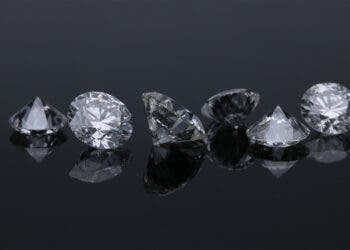In the U.S. and Canada, more than half of the deceased are cremated. The ashes of a loved one are typically placed inside an urn and displayed at the home of the family or scattered in a particular place that held a special meaning to the deceased person, such as a lake or mountain. Most recently, there’s a third option available to family members for the ashes of their dearly departed: turn carbon-rich ash into diamonds to be worn as jewelry.
If you’re intrigued about how all of this works, read on.

How natural and synthetic diamonds are made
You might be surprised to learn that the seemingly indestructible diamonds and the fragile graphite from which pencil leads are both made of the same stuff: pure carbon. Essentially, diamond and graphite, as well as buckminsterfullerene (the soccer-ball-shaped molecule containing carbon 60 atoms) are all allotropes of carbon — different forms of the same chemical element.
Their incredibly distinct properties are due to the way each material is arranged in different crystal structures. Diamonds are so hard because their carbon atoms are arranged tetrahedrally, resulting in a rigid three-dimensional structure that is phenomenally resistant to compression.
Despite what you might have heard in your high school science classroom, diamonds have nothing to do with coal. Coal is the product of ancient trees and vegetation that got buried deep underground, where it was subjected to high temperature and pressure. The vast majority of diamonds, however, predate the first plants by billions of years and are formed through completely different geological processes.
In nature, diamonds were formed billions of years ago deep within Earth’s crust under conditions of intense heat and pressure. Typically, diamonds form at depths of around 150-200 kilometers below the surface of Earth, where temperatures average 900 to 1,300 degrees Celsius and the pressure is around 50,000 times greater on the surface. Due to occasional magma eruptions, diamonds are forced away from Earth’s belly to the surface in diamond-bearing rock.
Since diamonds are so rare, geologists sought to develop methods to create artificial diamonds. It was only in the 1950s that Swedish and American scientists finally discovered how to convert graphite and molten iron into a synthetic diamond, fulfilling the literary prediction of Jules Verne.
To produce synthetic diamonds, manufacturers employ two main methods:
- high pressure, high temperature (HPHT) or
- chemical vapor deposition (CVD)
During HPHT, carbon is subjected to similarly high temperatures and pressures as the carbon that turned into diamonds billions of years ago. The second method, CVD, adds another step to HPHT. Manufacturers will cut a small slice of a diamond seed previously created through HPHT and place it into a high-temperature chamber filled with gas rich in carbon.
Ashes to diamonds
Since the human body is mostly made of water, most of the tissue will vaporize during cremation, forming gases that are released through an exhaust system.
What remains in the cremation chamber is mostly charred bone fragments, which are passed through a magnetic field in order to extract any metal particles. The bone fragments are then crushed into about five pounds of grayish powder — the deceased person’s ashes.
However, turning these ashes into diamond cremation jewelry is not straightforward. The ash isn’t made of pure carbon but rather carbonates and calcium phosphate, with trace amounts of other elements and molecules.
The carbonate is isolated and then decomposed into elemental carbon through a high-heat reduction process in the absence of oxygen. The process produces graphite, which represents around 1% to 4% of the total mass of a person’s ashes.
This graphite is then superheated again to get rid of any impurities, such as salts and boron, leaving graphite that is 99.995% pure carbon. Then from this graphite, high-pressure high-temperature technology, or HPHT, is used to simulate the crushing conditions of natural diamond growth deep within the earth’s crust, in order to convert this carbon from graphite into the diamond allotrope.
The pressure employed to turn the graphite into synthetic diamonds is equivalent to 450 tons sitting on a surface that’s as large as the bottom of a glass.
We’re nearing the final stages of the product — but first, the rough diamond has to be polished. Since these diamonds are typically incorporated into various jewelry — necklaces, rings, etc. — the polishing doesn’t usually take place in a lab.
The end result is a diamond containing a significant proportion of carbon atoms that were present in the body of the deceased person at the time of death, making this a unique way to preserve the memory of a loved one.






